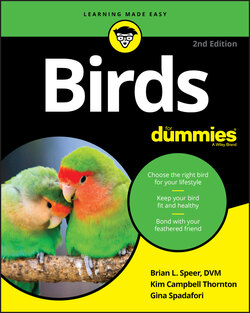Читать книгу Birds For Dummies - Gina Spadafori - Страница 101
CHEAP! CHEAP! AND FUN, TOO!
ОглавлениеToys can really break your budget, especially if you have a very destructive parrot. No matter how much you love your bird, you’re bound to mutter under your breath the first time you watch him gleefully and quickly destroy a toy you spent $20 on just a few hours before. Keep in mind, though, that aggression toward toys and perches is better than destructiveness directed toward your bird’s mental stability, his feathers, or you. Tearing toys up is properly channeled normal behavior for most parrots, and a very good thing. Just keep reminding yourself of that — again, and again, and again.
Fortunately, some alternatives to expensive store-bought toys exist, but you need to rely on creativity to find them.
The cardboard cores of toilet-paper and paper-towel rolls are perfect for shredding, especially for smaller birds. String those tubes together on a thick leather cord and hang them in your bird’s cage for his discovery and play. Other cheap options include ballpoint pens with the ink tubes removed, Ping-Pong balls, old plastic measuring cups and spoons, and plastic bottle tops.
Toothbrushes are another bargain toy, sturdy and colorful. You can buy them new or give your pet your worn ones — just be sure to run them through a hot, soapy wash and rinse first. Hard plastic keys on a ring for babies or puppies are also a budget-wise buy that birds love, and real keys can be just as fun. Stringing these “jewels” onto leather shoelaces and hanging them in cages provides a very low cost, very big entertainment thrill for your bird.
Keep your eyes and mind open for playthings — you may surprise yourself with the possibilities. Think cardboard boxes, magazines or newspapers inserted with their pages down into the top of the bird’s cage, and paper cups or cupcake liners. Use your imagination!
Remember, however, that really none of these items is intended for consumption. If your bird is able to chew them apart and potentially eat them, it may be time to rethink what you offer.
Some birds are apprehensive about new toys. If yours is one of them, try to set the toy outside the cage (but within eye range) for a day or two and then put it on the floor of the cage for another day or two. You also can place desired food items near it, to help your bird learn that yummy stuff accompanies that new thing. If your bird starts to play with the toy, you can hang it up permanently — or at least as permanently as possible with a playful and powerful bird. If he starts screaming and flattening his feathers against his body when the toy is placed at a certain distance, move it back to where he was comfortable with the toy’s presence. Wait longer and move more slowly in reintroducing it. Reward your bird with a special treat, a head scratch, or whatever he especially likes any time he doesn’t show fear or try to escape from the new item.
Harness and leash getups are a recent invention, geared for larger parrots. With a harness, you can take your parrot along when you’re running errands or visiting friends, without worrying about him getting away. (Even a wing-clipped bird can achieve enough loft to escape — it’s just harder.) Harnesses can add a lot to a companion bird’s life. Just think about it! You can harness up your buddy, let him perch on your shoulder, and go out for a walk. How fabulous is that! Not all birds benefit from this, of course, and no bird should be forced into a harness that he’s afraid of or doesn’t understand. But it’s definitely something to consider when thinking of ways to enrich your bird’s life. For more on the basics of harness training, see Chapter 20.
